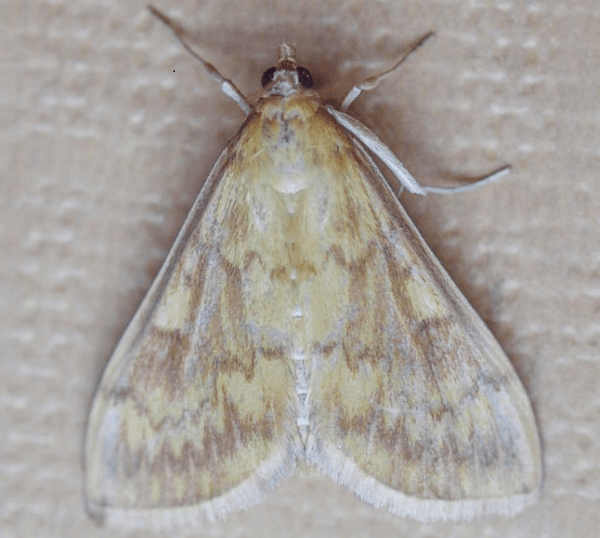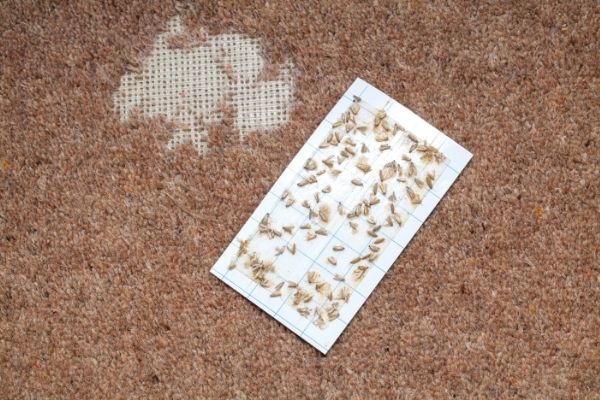Maggots can be persistent pests to keep from carpets or rugs. That is the reason that preventing maggots is better than fighting them. If you already have a maggot infestation, this article teaches you how to get rid of maggots in carpets. You will certainly get rid of the problem by following the 4 steps below.

The maggots that usually cause damage to carpets and rugs are actually moth larvae. They eat all kinds of natural fibers all year round, including that from carpets and rugs. The adult moths are relatively harmless, but they ensure the persistence of the problem.
Effective moth control therefore focuses on the adult moths, the maggots and the eggs.
Maggots are mainly found in quiet and dark environments, such as behind sofas, along baseboards, under bookcases and other such places. Vacuuming these areas well and providing more light will significantly reduce the problem of maggots in carpets and rugs.
This page contains affiliate links, and as an Amazon Associate we earn from qualifying purchases which means we receive a small commission when you make a purchase, at zero cost to you.
How to Know If There are Moths and Maggots in the Carpet
Moths and maggots can cause a lot of damage to carpets and rugs, but that they are moths or maggots is not always easy. There are many explanations for a frayed carpet or rug that has been separated. Read on to find out how to spot moths and maggots in a carpet or rug.
Recognizing the carpet moth
The carpet moth is smaller than a regular house moth as you will find it in your wardrobe or kitchen. With a body of about 5 mm long, you immediately notice a difference in size.
Carpet moths are whitish to pale yellow in color and usually have dots on the forewings. The rear wings are smaller and lighter in color in comparison.

The carpet moth can fly, but you will rarely see it. More often you will see this moth take a small, short jump.
The case-bearing clothes moth (Tinea pellionella) is another moth species that you will encounter a lot in carpets. This species is considerably larger than a carpet moth and can grow up to 9 mm in length. In terms of color, it is more often greyish than yellowish.
The life cycle of a carpet moth
In an ideal environment in terms of heat and humidity, an egg can grow into an adult moth within 2 months. If the levels differ in heat and humidity, the life cycle can last up to 2 years.
In two months to two years, a moth moves from egg to nymph, from larva to adult.
Due to better insulation of houses and rising temperatures, moths can now reproduce all year round. Although you will notice fewer moths in the winter months because the larvae develop more slowly, you can still suffer from moths all year round.
Check for maggots in rugs or carpets
The easiest way to find out if you have maggots in the carpet is to actually see them. Most of the time, you will notice movement where you don’t expect it, such as under sofas and cupboards.
But you can not only tell by the maggots themselves, the carpet or rug can also say something about the presence of maggots. If there is damage in places where you would not expect it, for example, because no one is walking in that place, then chances are that maggots are the culprits.
A good way to find out if you actually have moths is by placing a moth trap. You unfold this and place it on the carpet. The next morning you can check whether you actually have moths in the carpet or not.

A suitable moth trap is, for example, this:
Effective Maggot Control in Carpets and Rugs
Broadly speaking, there are two different ways to control maggots in carpets. You can choose a natural treatment or a chemical treatment.
Controlling maggots with chemical agents is easy and fast, but can have disadvantages if you expect children or pets in the room, for example.
Natural pesticides are very effective
Natural pesticides against maggots are often just as effective as chemical pesticides. Often you have to apply them a little more often or they are slightly more laborious, but a natural choice does not affect the end result in terms of effectiveness.
For a natural solution against moths, I recommend using a good spray as well as using a steam cleaner. In terms of spray, I am in favor of the product Dr. Killigan’s Six Feet Under Non-Toxic Insect Killer Spray.
To use this product, spray it – after very thorough vacuuming – under furniture and along all baseboards in the affected room. Let it dry thoroughly before returning to the room.
When you spray this product around the room, you will see that it works against all kinds of different insects!
It is then highly advisable to thoroughly clean the carpet in question using a steam cleaner. The advantage of this is that the heat from a steam cleaner also kills the maggots and moth eggs that are deep in the carpet fibers.
Once you’ve gone through the above advice, using cedar mothballs or essential oils can help ward off new invaders.
Chemical pesticides for fastest results
The most effective and safe insecticide you can use against moths is pyrethrum. This is a chemical based on a substance that occurs naturally in chrysanthemum flowers.
The extract from these flowers contains about 50% active insecticidal ingredients known as pyrethrins. These substances act on many types of insects and paralyze their nervous systems.
Are pyrethrins safe?
Pyrethrins are one of the safest insecticides available. They are so safe that they are even used on flea collars and in flea shampoos for dogs and cats.
Another reason why pyrethrins are recommended is that they often do not act on dyes and are therefore suitable for use to combat maggots in carpets. It is of course important to read the instructions for use carefully before using it.
The best chemical pesticides for moths and maggots
There are so many different products available against moths and maggots that sometimes you can no longer see the forest for the trees. Below you will find my tip for the very best pesticide.
As you can read above, Dr. Killigan’s Six Feet Under Non-Toxic Insect Killer Spray is my absolute favorite when it comes to controlling moths. This spray can not only be used against moths but against almost all insects. Due to the mix of insecticides, it has a direct effect on all insects in the environment. Not just moths.
How to Get Rid of Maggots in Carpet
To get rid of maggots in carpets in the most effective and efficient way, I recommend fighting the maggots in 4 steps. I explain those steps to you below.
Before you get started with moth and maggot control in carpets, it’s important to take a few precautions:
- Make sure that pets and children are out of the room during the process
- Cover any aquariums, terrariums and other containers that animals can live in properly
- Use a pair of disposable gloves
Step 1: Vacuuming and moving furniture
After finding out that you have maggots in the carpet, the first step is to vacuum thoroughly. Do not only vacuum in and around the specific locations where the contamination is suspected but take the entire room with you.
Vacuum thoroughly along baseboards and under and next to furniture. Maggots can also grow under furniture if it appears to be lying flat on the carpet.
After the first round, it is important to move all the furniture for a while and also to vacuum the places where the furniture was.
If possible, vacuum both sides of the carpet or rugs.
When you are done, it is important to empty the vacuum cleaner in a sealable garbage bag and throw it away outdoors.
Step 2: Steam!
Use a good steam cleaner to steam carpets and rugs. Heat is often the best weapon against moths and their eggs, so take advantage of that.
Be careful with carpets and (expensive) rugs that cannot withstand heat. If your steam cleaner cannot be set in temperature, you will have to have it professionally cleaned.
You can rent a steam cleaner at most do-it-yourself stores and hardware stores, but can also be obtained online for a small price. Click here for the range of steam cleaners on Amazon.com or choose the all-rounder below that I also have at home:
Step 3: Apply a moth repellent
Use a good pyrethrin-based insecticide. Apply this, if the material to be treated allows it, to the carpet, skirting boards, and adjacent surfaces.
The agent should also – if possible – be applied to the back of the carpet or rug.
Depending on the product, you need to let it work for some time, but follow the directions on the label.
Most products have a fast-killing effect on contact with the maggots, but also have a repellent effect up to three weeks after application. This depends on the particular agent you have used, so you will need to consult the label for the exact duration of action.
Click here to view the range of moth repellants on Amazon.com. You can also directly opt for this spray with a duration of action up to 3 months:
Step 4: Repeat steps 1 to 3
If you occasionally treat a carpet or rug against moths, you probably won’t have gotten all of the eggs. It is therefore important to repeat the treatment.
Perform this treatment once every two weeks. After the third time, you can be sure to get rid of the moth and maggot problem. Unless they have settled elsewhere such as in the wardrobe or in your kitchen.
How to Prevent Maggots in Carpets
The most effective way to prevent damage from maggots is to keep textiles clean. Spilled liquids must be cleaned up immediately. Carpet, rugs, curtains, etc. should be vacuumed or steamed regularly. Most insects will generally not attack clean materials.
Good lighting also works very well against maggots. Moths will want to place their eggs in a dark environment and avoid the light as much as possible. Also, since adult moths like dark and quiet environments, this solution can help keep them away.
Spilled food, pet food, drinks and the like attract moths. Anything that gets stuck in the fibers of the carpet and is a food source for moths attracts them. Make sure that you clean up accidentally spilled food and drinks immediately.
Because maggots like dark and quiet environments, the most covered areas of the carpet are often where you will find them. To avoid this, turn the carpet or rug regularly to ensure even protection.
Also, vacuum the back of rugs and carpets if possible. This gives you even better access to the eggs and the maggots than from the top.
Provide proper cleaning of pet accidents on fabric. The steam cleaner can help you with this.
Expensive Antique Rugs and Carpets
Many fine rugs are made from natural fibers, such as wool, which over time lose their natural oily properties and become drier, making them easier to infest than new rugs.
While there is nothing you can do about the age of the rug, you can prevent your antique rug from becoming a target for maggots by keeping it clean. A clean rug will be much less prone to insects than a dirty rug.
You should also vacuum your rugs regularly and not just the highly visible areas. Objects on the rug should therefore always be moved so that you can vacuum underneath. In addition, it is important to regularly clean the back (or have it cleaned).
For antique rugs, you should turn them at least once a year. In addition to preventing maggots, turning the rug will also help keep your rug looking good for longer.
Finally, good air circulation and low humidity help keep rugs and carpets free of moths and other insects for longer.

